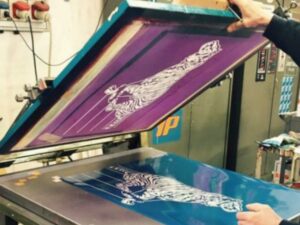Achieve perfect screen prints with our emulsion calculator for plastisol ink. Discover essential tips and formulas for precise emulsion measurements.
1. Harnessing the Power of Emulsion Calculators for Flawless Screen Prints
Screen printing requires precision, and the application of emulsion plays a critical role in ensuring your prints turn out sharp and clear. Over- or under-applying emulsion can lead to poor-quality results. An emulsion calculator is your go-to tool for determining the right amount of emulsion based on your screen size, mesh count, and coating method. Whether you’re a beginner or a seasoned pro, understanding how to use this tool will streamline your process and improve efficiency.
In this guide, we’ll walk you through how the emulsion calculator functions, how to calculate emulsion for your screen prints, and answer key questions like “How much emulsion is needed?” and “What’s the correct way to measure emulsion?”
2. Calculating Primary Emulsion for Šilkografija Perfection
The first layer of emulsion, or primary emulsion, is crucial for creating a durable stencil that holds your design. The goal is to apply the right amount—enough for durability but not too much to avoid excess buildup.
To accurately estimate the amount of primary emulsion, consider these factors:
- Mesh Count: Higher mesh counts (e.g., 230 mesh) require less emulsion compared to lower mesh counts (e.g., 110 mesh).
- Screen Dimensions: Larger screens, like a 24×36 inch frame, will require more emulsion than smaller screens, like a 12×16 inch one.
- Coating Technique: The method of coating, whether using a scoop coater or hand-coating, will influence how much emulsion is used.
With these variables in mind, an emulsion calculator can precisely calculate the right amount of emulsion for your screen printing needs.
3. The Quest for the Perfect Emulsion Quantity
A common challenge in screen printing is knowing exactly how much emulsion is required. Too much can lead to overexposure and messy prints, while too little can create weak stencils. The amount of emulsion needed depends on several factors:
- Mesh Count: Finer mesh (e.g., 160 mesh) needs less emulsion, while coarser mesh (e.g., 110 mesh) needs more.
- Coating Method: A scoop coater applies emulsion more evenly and usually uses less, while manual application may require a bit more.
- Coat Number: Typically, two coats (one on the front and one on the back) are applied. The thickness of each coat is essential to achieve optimal stencil exposure.
An emulsion calculator is an ideal solution to determine the exact emulsion needed, saving you time and effort by giving you a precise measurement based on your unique setup.
4. Streamlining Emulsion Measurement with a Simple Formula
Measuring the right amount of emulsion can be a tricky task, but with a few clear steps, the process becomes easier:
- Screen Dimensions: Larger screens (like 24″x36″) need more emulsion, while smaller ones (like 12″x16″) need less.
- Mesh Count: Higher mesh counts (e.g., 230) demand less emulsion compared to lower mesh counts (e.g., 110).
- Coating Process: The method you use for applying emulsion affects the quantity needed.
Inputting these values into an emulsion calculator provides you with the most accurate emulsion measurement, eliminating the need for guesswork and trial and error.
5. Understanding the Emulsion Ratio and Its Importance
The emulsion ratio is vital for ensuring a balanced emulsion mixture. It refers to the ratio between the emulsion and sensitizer, a critical element that makes your emulsion light-sensitive for exposure.
The most common emulsion ratios are:
- 1:1 Ratio: Equal parts emulsion and sensitizer.
- 2:1 Ratio: Two parts emulsion to one part sensitizer.
This ratio influences the exposure time and the durability of the stencil. An improper balance can result in overexposure or underexposure. Using an emulsion calculator helps you determine the right amount of sensitizer based on your emulsion quantity, ensuring a perfect mixture.
6. Reliable Techniques for Determining Emulsion Needs
There are several methods to calculate the right emulsion amount for screen printing. Here’s a breakdown of the top techniques:
- Trial and Error: This method involves experimenting with different amounts of emulsion and adjusting accordingly. It can be effective over time but wastes materials and time.
- Manufacturer Guidelines: Many emulsion manufacturers provide charts or guidelines for estimating emulsion needs based on screen size and mesh count. While helpful, these guides may lack precision.
- Emulsion Calculator: The most accurate and reliable method is to use an emulsion calculator. It calculates the exact amount of emulsion based on your screen size, mesh count, and coating method, helping you avoid wastage and ensuring consistent results.
Although trial and error might work, the emulsion calculator provides precise, reliable measurements to ensure you’re using the correct amount of emulsion every time.
Conclusion: Perfect Your Screen Spausdinimas Workflow with an Emulsion Calculator
For screen printers working with plastisol ink, precision is key—especially when it comes to emulsion application. The emulsion calculator is an invaluable tool to get the exact amount of emulsion every time, reducing waste and ensuring high-quality prints.
By factoring in important elements like screen size, mesh count, and coating method, this tool enables you to streamline your process and achieve consistently sharp, clean prints. Whether you’re just getting started or are an experienced screen printer, an emulsion calculator will elevate your workflow and improve your results.

